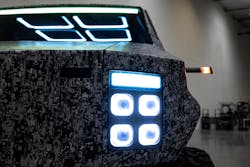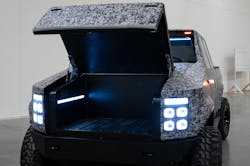Atlis unveils EV prototype pickup built for work
Atlis Motor Vehicles has taken the four years since its founding to develop a battery cell and ultra-fast charging platform—and now has delivered the first complete vehicle built atop that platform: the all-electric XT work pickup truck.
Atlis founder and CEO Mark Hanchett and president Annie Pratt debuted the gadget-laden XT prototype during a virtual walk-through from the company’s Mesa, Arizona, headquarters on Sept. 27. Atlis said the vehicle meets the size, towing, and payload capabilities of its legacy diesel rivals, but without the tailpipe emissions.
In terms of “refueling,” this XT’s recharging capability also is built to be just as convenient as its diesel counterparts, according to Atlis.
The company is developing a proprietary 1.5MW system that can charge the truck through a port near the driver door in 15 minutes. Once fully charged, the XT can go 500 miles, the company said. For added convenience, the EV work pickup includes Combined Charging System/J1772 ports that connect to any existing recharging station along the road today.
As for specs, the chassis of the Atlis XT can handle 10,000 lb. per axle, so it has a 20,000-lb. gross vehicle weight rating, Hanchett noted. Its air suspension system assists with loading and unloading by lowering for easy access. The truck has a 35,000-lb. towing capacity and a 5,000-lb. payload limit. Peak torque is 12,000 ft.-lb., horsepower is 600hp, and top speed of this new all-electric is 120 mph.
A more refined production version of the XT pickup will launch toward the end of next year, Hanchett noted. “The prototype contains all the different tech and approaches that Atlis will be taking into the final production product,” he added during the virtual tour.
Big on gadgetry, built for the worksite
Front to back, the XT is as high-tech as any EV. It has more ports and outlets than an Apple Store, and LED lights and bars illuminate every space of the truck—front to back, inside the cab and out. According to the company, future Atlis XTs may even function as emergency vehicles, so the LED lights and headlights are upgradable for such uses.
The XT is powered by the AMV battery cell (also debuted this year) built into the XP chassis—so under the hood is a “frunk,” a storage space forward of the windshield that features 240V/50A and 120V/20A outlets that can power welders, compressors, power tools and has space for toolboxes, materiel buckets, extension cords, and the like. The production Atlis XT also will have USB ports to charge cellphones and tablets. The frunk has 18.5 cu. ft. of space—more storage than any electric pickup, according to Atlis.
Similar power outlets in the bed of the truck run on a separate circuit from those in the frunk, Hanchett emphasized, so someone can run the same kinds of gear—at the same time—as someone at the front of the truck, making the Atlis XT a potential worksite workhorse. The 6.5’-by-8’ composite, LED-lit bed has a standard spray-in protective liner. Tow hooks are built into it.
Also, being all about functionality, there will be no need to have step bumpers installed on the Atlis XT. They are built in all around into the chassis as part of the XP battery platform.
Cameras replace rear-view mirrors
The all-electric vehicle lacks old-school rear-view mirrors; instead, it uses cameras that emerge from doors on each side of the truck and stay in one position for normal driving. They extend 6” farther out when the XT detects a trailer in tow. The rear-view cameras have a 180-degree field of view.
The cameras link to screens on either side of the steering wheel in the cab, so the driver doesn’t have to look out of his or her field of vision to see events on either side of the pickup.
Inside the cab, the “rear-view screens” are joined by a center display with Apple CarPlay and Android audio. “Everything onscreen in the user interface is within two or three clicks,” Hanchett said.
The prototype XT did not have steering-wheel controls, but they will arrive in the production version, he said. There are multifunction paddles alongside the steering wheel that can control the brakes on a trailer in tow, independent of the XT’s own braking system.
Nooks for storage and wireless charging
Elsewhere in the cab, a fold-down center console has wireless charging for mobile devices, as well as cupholders. There also is wireless charging for devices in the doors and on the dashboard.
The front and rear seats are identical and can fit larger adults—6’-plus. The LED lights in the roof of the cab also are a notable feature.
Hanchett said “plenty of customers” are lining up to purchase the XT, to the tune of 60,000 nonbinding reservations with deposits that function as investments in the company.
The first 150 production models will roll out at the end of 2022 that will be manual builds, he said. They will be assembled in Mesa. A typical production line is farther off for Atlis until the XT gets a foothold in the marketplace, Hanchett added.
About the Author
Scott Achelpohl
Managing Editor
Scott Achelpohl is a former FleetOwner managing editor who wrote for the publication from 2021 to 2023. Since 2023, he has served as managing editor of Endeavor Business Media's Smart Industry, a FleetOwner affiliate.



